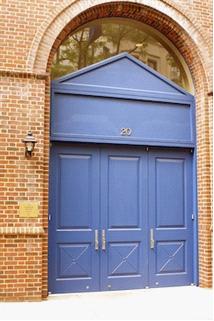
The Story of Nightingale-Bamford School
USINFO | 2013-12-09 13:41

We’ve mentioned our 90th Anniversary a few times this winter, and later this month you’ll receive a special edition of the Blue Doors magazine that honors both the past and the future of this great school. It seems fitting, now, to tell the story of how the Nightingale-Bamford School came to be.
Frances Nightingale grew up in Brunswick, Georgia, and somehow found her way to New York City, where she began to tutor younger students at the Upper East Side home of Philip G. Bartlett, a partner in the firm of Simpson Thatcher and Bartlett, in 1906. Over the next few years, she gained more students, moved locations a few times, and in 1918 began “Miss Nightingale’s Classes” officially. The following year she met Miss Bamford, who was Irish-born and Oxford-educated and was at the time the head of the mathematics department at the Bryn Mawr School in Baltimore, Maryland. Miss Bamford tells the next part of the story quite beautifully:
The enthusiasm with which [Miss Nightingale] sketched for me her vision of the future was instantly contagious. The little girls, whose voices I could hear outside the room where we sat; the little girls whom she had guided and loved since Kindergarten age, were now beginning to grow up and were getting too old for “Miss Nightingale’s Classes.” They did not want to begin all over again in a strange school. She did not want to let them go. Why could she not change her “Classes” into a school—a good school, primarily, where the children, as they grew older, could be prepared for college… but always a small and friendly school, preserving the happy freedom, the pleasant intimacy and understanding of the “Classes?” The school would progress and advance with the times, but not so rapidly that its fundamental ideal could ever be blurred.
So Miss Bamford joined Miss Nightingale and the next year, in 1920, they moved to two brownstones here on 92nd Street, the first permanent home of the burgeoning school. The first class of four young women graduated in 1925 in what was reported as a truly touching ceremony at the Colony Club, and four short years later, the brownstones were replaced with a brand new schoolhouse. (Next time you’re at Nightingale, stop by the first floor to see a blueprint of the original building, hanging above Miss Nightingale’s piano.) 1929 marked not only the first year in their new home, but also the year that Miss Nightingale changed the name of the school to acknowledge both of its founders. And, thus, we became the Nightingale-Bamford School.
Miss Nightingale ran the school for another 10 years, securing an educational charter from the State of New York in 1939, at which time she retired and handed the reins to Miss Bamford. It is so remarkable to think how much these two women were able to accomplish in such a short time—just two decades from children’s classes scattered around the neighborhood to a fully fledged college preparatory school in an impressive and beautiful building. We have large shoes to fill!
Sharing the same home state of Georgia with Miss Nightingale, I’ve often wondered what prompted her to come to New York City in the early 1900s, a mystery that I’ve never been able to solve. Our “official” founding date also been somewhat confusing. We have always celebrated 1920 as the year of our founding, and yet it’s clear from the story above (and from hundreds of historical documents in our archives) that there were plenty of other years that could have been used as the starting date. So why 1920? That was the year we acquired property of our own, certainly, but I like to think it was also a conscious choice to recognize the 19th Amendment, ratified in August of that year. Miss Nightingale and Miss Bamford, as much as we do today, sought to celebrate and support the individual voice of every girl that passed through their doors—and what could be better than connecting our school to the moment when women all across America won the right to use that voice?
Share this page



















